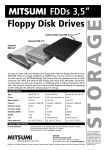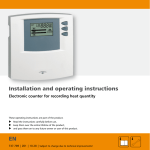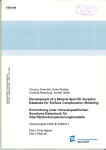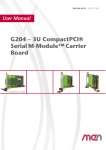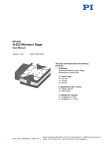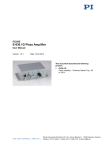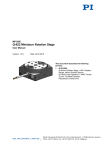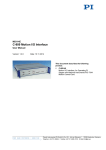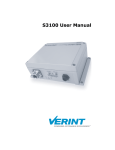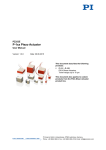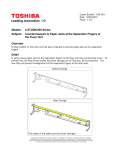Download Bedienungsanleitung VHQ
Transcript
Spezialelektronik GmbH Precision High Voltage Supply VME STANDARD series Operators Manual Contents: 1. General information 2. Technical Data 3. VHQ Description 4. Front panel 5. Handling 6. VME Interface 7. Program example Appendix A: Block diagram Appendix B: Rotary switch locations Attention! -It is not allowed to use the unit if the covers have been removed. -We decline all responsibility for damages and injuries caused by an improper use of the module. It is highly recommended to read the operators manual before any kind of operation. Note The information in this manual is subject to change without notice. We take no responsibility whatsoever for any error in the document. We reserve the right to make changes in the product design without reservation and without notification to the users. Filename VHQx0x.___; version 3.00 as of 24.09.2004 iseg Spezialelektronik GmbH Bautzner Landstr. 23 D - 01454 Radeberg / Rossendorf Email: [email protected] http://www.iseg-hv.com Germany Phone ++ 49 351 / 26 996 - 0 Fax ++ 49 351 / 26 996 - 21 Spezialelektronik GmbH 1. General information The VHQ´s are two channel high voltage supplies in 6U VME format, 164 mm deep, double width. The units offers manual control and operation via VME bus. The use of the VME interface supports more then the manual control functionality. The high voltage supplies special provide high precision output voltage together with very low ripple and noise, even under full load. Separate 10%-steps hardware switches put voltage and current limits. An INHIBIT input protects connected sensitive devices. Additionally, the maximal output current per channel is programmable via the interface. The high voltage outputs protected against overload and short circuit. The output polarity can be switched over. The HV-GND is connected to the chassis and the powering GND. 2. Technical data: VHQ two channel 202 M 203 M 204 L 205 L Output voltage VO 0 ... 2 kV 0 ... 3 kV 0 ... 4 kV 0 ... 5 kV Output current per channel IO 0 ... 3 mA 0 ... 2 mA 0 ... 1 mA 0 ... 1 mA with option M - h 0 ... 6 mA 0 ... 4 mA 0 ... 3 mA 0 ... 2 mA with option _104 100 µA 100 µA 100 µA 100 µA < 1 mVP-P < 2 mVP-P 2 mVP-P 5 mVP-P Ripple typ. max. Stability < 0,5 mVP-P < 0,5 mVP-P 2 mVP-P 2 mVP-P ∆VO <5 ∗ 10 -5 ∆VO/∆VINPUT <5 ∗ 10 -5 VHQ 205L 2 x 5 kV / 1 mA (idle to max. load) <5 ∗ 10-5 /K Temperature coefficient LCD Display 4 digits with sign, switch controlled voltage display in [V] / current display in [µA] Resolution of measurement Current: 1 µA, with option _104: 100 nA Voltage: 1 V Accuracy current measurement ±(0,05% IO + 0,02% I O max + 1 digit) Accuracy voltage measurement ±(0,05% VO + 0,02% VO max + 1 digit) (for one year) Voltage CONTROL switch in upper position: (for one year) 10 - turn potentiometer control lower position (DAC): control via interface Rate of change of hardware ramp 500 V/s (on HV-ON/ -OFF) output voltage software ramp: 2 . . . 255 V/s Protection - separate current and voltage limit (hardware, rotary switch in 10%-steps) - INHIBIT (ext. signal TTL-level, Low = active ⇒ VOUT=0) - programmable current limit (software) Current trip reaction time < 60 ms Power requirements VINPUT ± 12 V ( < 850 mA, with option M - h < 1,6 A) + 5 V ( < 300 mA) Packing VME #2 / 6U / 164 mm deep Connector 96-pin VME connector according to DIN 41612 HV connector SHV-Connector at the front panel INHIBIT connector 1-pin Lemo-hub Operating temperature Storage temperature iseg Spezialelektronik GmbH Bautzner Landstr. 23 D - 01454 Radeberg / Rossendorf 0 ... +50 °C -20 ... +60 °C Email: [email protected] http://www.iseg-hv.com Germany Phone ++ 49 351 / 26 996 - 0 Fax ++ 49 351 / 26 996 - 21 2 Spezialelektronik GmbH 3. VHQ Description The function is described at a block diagram of the VHQ. This can be found in Appendix A. High voltage supply A patented high efficiency resonance converter circuit, which provides a low harmonic sine voltage on the HVtransformer, is used to generate the high voltage. The high voltage is rectified using a high speed HV-rectifier, and the polarity is selected via a high-voltage switch. A consecutive active HV-filter damps the residual ripple and ensures low ripple and noise values as well as the stability of the output voltage. A precision voltage divider is integrated into the HV-filter to provide the set value of the output voltage, an additional voltage divider supplies the measuring signal for the maximum voltage control. A precision measuring and AGC amplifier compares the actual output voltage with the set value given by the DAC (computer control) or the potentiometer (manual control). Signals for the control of the resonance converter and the stabilizer circuit are derived from the result of the comparison. The two-stage layout of the control circuit results in an output voltage, stabilized with very high precision to the set point. Separate security circuits prevent exceeding the front-panel switch settings for the current Imax and voltage Vmax limits. A monitoring circuit prevents malfunction caused by low supply voltage. The internal error detection logic evaluates the corresponding error signals and the external INHIBIT signal. It allows the detection of short overcurrent due to single flashovers in addition. Digital control unit A micro controller handles the internal control, evaluation and calibration functions of both channels. The actual voltages and currents are read cyclically by an ADC with connected multiplexer and processed for display on the 4 digit LCD display. The current and voltage hardware limits are retrieved cyclically several times per second. The reference voltage source provides a precise voltage reference for the ADC and generation of the control signals in the manual operation mode of the unit. The set values for the corresponding channels are generated by a 16-Bit DAC in computer controlled mode. Filter A special property of the unit is a tuned filtering concept, which prevents radiation of electromagnetic interference into the unit, as well as the emittance of interference by the module. A filtering network is located next to the connectors for the supply voltage and the converter circuits of the individual devices are also protected by filters. The high-voltage filters are housed in individual metal enclosures to shield even minimum interference radiation. iseg Spezialelektronik GmbH Bautzner Landstr. 23 D - 01454 Radeberg / Rossendorf Email: [email protected] http://www.iseg-hv.com Germany Phone ++ 49 351 / 26 996 - 0 Fax ++ 49 351 / 26 996 - 21 3 Spezialelektronik GmbH 4. Front panel [1] [2] [3] [4] [5] [6] [7] [8] [9] [10] [11] [12] [13] [14] 4 digit LCD display Channel switch Measuring switch Rotary switch Voltage limit Rotary switch Current limit Error indicator 10 - turn potentiometer HV-ON switch CONTROL switch KILL switch INHIBIT input HV-ON indicator HV-output Polarity indicator 5. Handling The state of readiness of the unit is produced at the VME connector on the flipside. The Output polarity is selectable with help of a rotary switch on the cover side (see appendix B). The chosen polarity is displayed by a LED on the front panel [14] and a sign on the LCD display [1]. Attention! It is not allowed to change the polarity under power! An undefined switch setting (not at one of the end positions) will cause no output voltage. High voltage output is switched on with HV-ON switch [8] at the front panel. The viability is signaled by the yellow LED [12]. Attention! If the CONTROL switch [9] is in upper position (manual control), high voltage is generated at HV-output [13] on the front panel with a ramp speed from 500 V/s (hardware ramp) to the set voltage chosen via 10-turn potentiometer [7]. This is also the case, if VME control is switched over to manual control while operating. If the CONTROL switch [9] is in lower position (DAC), high voltage will be activated only after receiving corresponding VME commands. iseg Spezialelektronik GmbH Bautzner Landstr. 23 D - 01454 Radeberg / Rossendorf Email: [email protected] http://www.iseg-hv.com Germany Phone ++ 49 351 / 26 996 - 0 Fax ++ 49 351 / 26 996 - 21 4 Spezialelektronik GmbH On the LCD [1] output voltage in [V] or output current in [µA] will be displayed depending on the position of the Measuring switch [3]. For the two channel units, one can choose with Channel switch [2], if channel (A) or channel (B) is displayed. If working with manual control, output voltage can be set via 10-turn potentiometer [7] in a range from 0 to the set maximal voltage. If the CONTROL switch [9] is switched over to VME control, the DAC takes over the last set output voltage of manual control. Output voltage can be generated with a programmable ramp speed (software ramp) from 2 to 255 V/s in a range from 0 to the maximal set voltage via VME control. The maximum output current per channel can be set with a programmable current trip via the interface with the resolution of current measurement. If the output current exceeds the programmable limit, the output voltage will be shut off permanently by the software. Restoring the voltage is possible after reading ” Status register 2” and then ”Start voltage change” via interface. Maximum output voltage and current can be selected in 10%-steps with the rotary switches Vmax [4] and Imax [5] (switch dialed to 10 corresponds to 100%) independently of programmable current trip. The output voltage or current, which exceed the limits, is signaled by the red error LED on the front panel [6]. Function of KILL switch [10]: Switch to the right position: (ENABLE KILL) The output voltage will be shut off permanently without ramp on exceeding Vmax, Imax or in the presence of an INHIBIT signal (Low=active) at the INHIBIT input [11]. Restoring the output voltage is possible after operating the switches HV-ON or KILL or reading ” Status register 2” and then ”Start voltage change” by DAC control. Note: When capacitance is effective at the HV-output or when the rate of change of output voltage is high (hardware ramp) at high load, then the KILL function will be released by the current charging the condenser. In this case use a small rate of output change (software ramp) or select ENABLE KILL not until output voltage is set voltage. Switch to the left position: (DISABLE KILL) The output voltage will be limited to Vmax, output current to Imax respectively; INHIBIT shuts the output voltage off without ramp, the previous voltage setting will be restored with hard- or software ramp on INHIBIT no longer being present. 6. VME Interface Modus: short supervisory access short nonprivileged access (AM = 0x2D) (AM = 0x29) Control via VME interface 1st write: 2nd switch: 3rd read: set voltage, ramp speed, maximal output current (current trip) output voltage = set voltage ; output voltage = 0 set voltage; actual voltage; ramp speed; actual current; current trip current and voltage hardware limit; status Front panel switches are having priority over software control. Manual control While the unit is operated in manual control mode, VME read cycles are interpreted only. Commands are accepted, but do not result in a change of the output voltage. iseg Spezialelektronik GmbH Bautzner Landstr. 23 D - 01454 Radeberg / Rossendorf Email: [email protected] http://www.iseg-hv.com Germany Phone ++ 49 351 / 26 996 - 0 Fax ++ 49 351 / 26 996 - 21 5 Spezialelektronik GmbH Command Execution Time The command execution time is 2 µs typical. Base Address The base address BA is saved in a EEPROM. Setting BA: 1. Set both channels of the unit before power requirements (± 12V; + 5V) are activated as follows: => CONTROL switch at MANUELL; => HV-ON switch at OFF; => KILL switch at ENABLE. 2. Activate power requirements. 3. LCD display shows ”A” on the left side and the highbyte of the base address (e.g. ”dd”) on the right side, with separator flashing in between. 4. High-order nibble can be set with channel switch and low-order nibble with measuring switch. 5. In case of no change for 10 s or of setting another switch respectively, the chosen base address is saved in EEPROM and the unit is responsive with it. 6. Factory setting: BA = 0xDD00 Register addresses The description for Channel B will be cancelled at the one channel unit. A7 A6 A5 A4 A3 A2 A1 0 0 0 0 0 0 0 0 0 0 0 0 0 0 0 0 0 0 0 0 0 0 0 0 0 0 0 0 0 0 0 0 0 0 0 0 1 1 1 1 1 1 0 0 0 0 1 1 1 1 0 0 0 0 1 1 0 0 1 1 0 0 1 1 0 0 1 1 0 0 0 1 0 1 0 1 0 1 0 1 0 1 0 1 0 0 0 0 0 0 0 0 0 0 0 0 0 0 Read Write Status register 1 Set voltage Channel A Set voltage Channel B [V] Set voltage Channel A (Vset ≤ Vmax) [V] [V] Set voltage Channel B (Vset ≤ Vmax) [V] Ramp speed Channel A (2... 255) [V/s] Ramp speed Channel A (2... 255) [V/s] Ramp speed Channel B (2... 255) [V/s] Ramp speed Channel B (2... 255) [V/s] Actual voltage Channel A [V] Actual voltage Channel B [V] Actual current Channel A * ) Actual current Channel B * ) Hardware limits Channel A (Imax , Vmax) Hardware limits Channel B (Imax , Vmax) Data ready Status register 2 Start voltage change Channel A 0 0 1 1 1 0 0 Start voltage change Channel B 0 0 0 0 0 1 1 1 1 0 0 0 1 0 0 0 1 0 0 1 1 0 1 0 0 0 0 0 Start voltage change Channel A with data: Set voltage Channel A Start voltage change Channel B with data: Set voltage Channel B [V] [V] Module identifier - - Current software limit Channel A Current software limit Channel A Current software limit Channel B Current software limit Channel B * with data: ) corresponding current resolution iseg Spezialelektronik GmbH Bautzner Landstr. 23 D - 01454 Radeberg / Rossendorf Email: [email protected] http://www.iseg-hv.com Germany maximal current Channel A/B corresponding current resolution, maximal current = 0 ⇒ not a current trip Phone ++ 49 351 / 26 996 - 0 Fax ++ 49 351 / 26 996 - 21 6 Spezialelektronik GmbH Status register 1 Channel B A (BA + 0x00) Bit Name Description 0 1 D15 ERROR_2 Error on Channel B Channel ok Error D14 STATV_2 Status VOut Vout stable Vout in change D13 TRENDV_2 Ramp up / down Vout falling Vout rising D12 KILL_2 KILL switch setting Disabled Enabled D11 ON_OFF_2 HV-ON/OFF switch setting On Off D10 POL_2 Polarity VOut Negative Positive D9 IN_EX_2 CONTROL switch setting DAC Manual D8 VZ_2 VOut = 0 Vout<>0 Vout=0 D7 ERROR_1 Error on Channel A Channel ok Error D6 STATV_1 Status VOut Vout stable Vout in change D5 TRENDV_1 Ramp up / down Vout falling Vout rising D4 KILL_1 KILL switch setting Disabled Enabled D3 ON_OFF_1 HV-ON/OFF switch setting On Off D2 POL_1 Polarity VOut Negative Positive D1 IN_EX_1 CONTROL switch setting DAC Manual D0 VZ_1 VOut = 0 Vout<>0 Vout=0 This register is representing the general status of the VHQ. ”Error“ is formed by the logic or of REG2ER_, REG1ER_, EXTINH_, RANGE_ and ILIM_ from ”Status register 2”. ”Vout=0” is formed by DAC output = 0 and actual voltage < 5 V. Set voltage Channel A/B (BA + 0x04 / BA + 0x08) Set voltage Vset from 0 to Vmax in V. If Vset greater then Vmax (BA + 0x24 / BA + 0x28), Vset will be not changed. Ramp speed Channel A/B (BA + 0x0C / BA + 0x10) Voltage ramp speed from 2 V/s to 255 V/s. All processor controlled changes in the output voltage are performed at this ramp speed. Actual voltage Channel A/B (BA + 0x14 / BA + 0x18) Output voltage Vout’ of the channels in V. Actual current Channel A/B (BA + 0x1C / BA + 0x20) Output current Iout of the channels corresponding current resolution. Hardware limits D0 .. D3 D4 .. D7 D8 .. D15 (BA + 0x24 / BA + 0x28) Maximal output current (Imax) in 10 %, hardware setting on the front panel switches Maximal output voltage (Vmax) in 10 %, hardware setting on the front panel switches 0 Data ready D7 0 (BA + 0x2C) D6 0 D5 0 D4 0 D3 Current B D2 Voltage B D1 Current A D0 Voltage A The individual bits are set as soon as actual measured data is existing. The bits are reset after the corresponding reading command. iseg Spezialelektronik GmbH Bautzner Landstr. 23 D - 01454 Radeberg / Rossendorf Email: [email protected] http://www.iseg-hv.com Germany Phone ++ 49 351 / 26 996 - 0 Fax ++ 49 351 / 26 996 - 21 7 Spezialelektronik GmbH Status register 2 (BA + 0x30) Bit Name Description D15 REG2ER_2 Quality of output voltage not given at present D14 Remark REG1ER_2 Vmax or Imax is / was exceeded Channel D13 EXTINH_2 External inhibit was / is active D12 RANGE_2 Vset to Vmax ratio > 1 D(BA+0x08) > Vmax D11 KEY_CHANGED A frontpanel switch position was changed ON_OFF_2, IN_EXT_2, KILL_2 D10 EOP_2 Vout has reached set value End of process_2 D9 ILIM_2 Iout was > Imax programmable Current trip REG2ER_1 Quality of output voltage not given at present B D8 D7 REG1ER_1 Vmax or Imax is / was exceeded Channel D5 D6 EXTINH_1 External inhibit was / is active D4 RANGE_1 Vset to Vmax ratio > 1 A(BA+0x04) > Vmax D3 KEY_CHANGED A frontpanel switch position was changed ON_OFF_1, IN_EXT_1, KILL_1 D2 EOP_1 Vout has reached set value End of process_1 D1 ILIM_1 Iout was > Imax programmable Current trip D0 TOT Timeout error New initialisation A The individual bits are set on the occurrence of the event. A general clear is performed after readout. If the Output voltage was permanently switched off by exceeding Vmax or Imax (ENABLE KILL resp. Current trip), or INHIBIT respectively, the error bits (REG1ER_, EXTINH_, ILIM_) have to be reset by reading ” Status register 2” before an output voltage can be set again. Start voltage change (BA + 0x34 / Ba + 0x38) A change in the output voltage of set voltage (BA + 0x04 / BA + 0x08) is performed by reading these registers. Writing to the registers stores the data as new set voltage (Vset ≤ Vmax) and starts the voltage change. The change of output voltage is blocked, if the conditions are unavailable to start voltage change corresponding these description. Command execution can be checked by reading status register 1 (BA + 0x00). The bits D14 (channel B), D6 (channel A) respectively are set on start of voltage change. Actual voltage reaching the set voltage is flagged by the bits D10, D2 of status register 2 (BA + 0x30) respectively. An interruption of the voltage change (e.g. external INHIBIT is active) is also ascertainable. Module identifier D15 .. D0 (BA + 0x3C) 4 digit serial number, BCD coded Current software limit (BA + 0x44 / BA + 0x48) The maximal output current per channel corresponding current resolution. If the output current exceeds the programmable limit, the output voltage will be shut off permanently by the software (Current trip). The Current trip reaction time is lessen to 60 ms. Writing to the registers with maximal output current = 0, not a current trip will be programmed. Hardware maximum output current limit (Imax) worked independently of programmable current software limit. iseg Spezialelektronik GmbH Bautzner Landstr. 23 D - 01454 Radeberg / Rossendorf Email: [email protected] http://www.iseg-hv.com Germany Phone ++ 49 351 / 26 996 - 0 Fax ++ 49 351 / 26 996 - 21 8 Spezialelektronik GmbH 7. Program example /**********************************************************************************/ /* vhq.c */ /* example program for iseg vme hv boards */ /* mki, 24.1.96 */ /* this code was compiled and run on an E6 under OS9 */ /* please contact iseg for the source files */ /**********************************************************************************/ #include <stdio.h> #include "vhq.h" #define base 0xFFFFDD00 int main() { ushort value_s; ushort serial; ushort imaxa,imaxb,vmaxa,vmaxb; value_s = *(ushort*) (base+MOD_ID); serial = (value_s >> 12)* 1000 + ((value_s & 0x0f00) >> 8) * 100 + ((value_s & 0x00f0 >> 4) * 10 + (value_s & 0x000f); printf("This board is serial no.: %d\n",serial); /* read board id */ value_s = *(ushort*) (base+STAT_REG1); if ((value_s & 0x202) != 0) { printf("one of the two channels is in manual mode\n"); printf("program terminating\n"); return(-1); } printf("both channels in DAC mode, ok.\n"); /* check on DAC/manual switch setting */ if ((value_s & 0x808) != 0) { printf("one of the two channels is OFF\n"); printf("program terminating\n"); return(-1); } printf("both channels ON, ok.\n"); /* check on HV ON/OFF switch setting */ if ((value_s & 0x4) != 0) printf("polarity of channel A is positive\n"); else printf("polarity of channel A is negative\n"); /* whats the output polarity? */ if ((value_s & 0x400) != 0) printf("polarity of channel B is positive\n"); else printf("polarity of channel B is negative\n"); sleep(1); value_s = *(ushort*) (base+LIMITS_A) vmaxa=((value_s & 0xf0) >> 4) * 10; imaxa=(value_s & 0x0f) * 10; printf("Vmax(A): %4d % %, Imax(A): %4d % %\n",vmaxa,imaxa); sleep(1); /* read Vmax and Imax */; value_s = *(ushort*) (base+LIMITS_B); vmaxb=((value_s & 0xf0) >> 4) * 10; imaxa=(value_s & 0x0f) * 10; printf("Vmax(B): %4d % %, Imax(B): %4d % %\n",vmaxb,imaxb); *(ushort*) (base+RAMP_SPEED_A) = 100; printf("ramp A set\n"); /* set ramp speed 100 V/s */ *(ushort*) (base+RAMP_SPEED_B) = 100; printf("ramp B set\n"); *(ushort*) (base+SET_CTRIP_A) = 100; */ printf("channel A current trip set\n"); /* set channel A software current trip to 100 µA *(ushort*) (base+SET_CTRIP_B) = 0; printf("channel B current trip set\n"); /* channel B without software current trip iseg Spezialelektronik GmbH Bautzner Landstr. 23 D - 01454 Radeberg / Rossendorf Email: [email protected] http://www.iseg-hv.com Germany */ Phone ++ 49 351 / 26 996 - 0 Fax ++ 49 351 / 26 996 - 21 9 Spezialelektronik GmbH *(ushort*) (base+START_VOLT_A) = 400; printf("channel A voltage set\n"); /*set channel A voltage to 400 V */ *(ushort*) (base+START_VOLT_B) = 350; printf("channel B voltage set\n"); /*set channel B voltage to 350 V */ sleep(5); /* give the unit time to ramp */ value_s = *(ushort*) (base+ACT_VOLT_A); printf("channel A is at %d V\n",value_s); /* read actual voltages */ sleep(1); /* allow for a new conversion */ printf("press any key to ramp down and exit\n"); getc(stdin); /* ramp channels down */ *(ushort*) (base+START_VOLT_A) = 0; sleep(1); /*set channel A voltage to 0 V */ *(ushort*) (base+START_VOLT_B) = 0; return(0); /*set channel B voltage to 0 V */ value_s = *(ushort*) (base+ACT_VOLT_B); printf("channel B is at %d V\n",value_s); } /***********************************************************/ /* vhq.h */ /* */ /* header file for iseg vme hv boards */ /* */ /* mki, 24.1.96 */ /***********************************************************/ /* vhq registers */ #define STAT_REG1 #define SET_VOLT_A #define SET_VOLT_B #define RAMP_SPEED_A #define RAMP_SPEED_B #define ACT_VOLT_A #define ACT_VOLT_B #define ACT_CUR_A #define ACT_CUR_B #define LIMITS_A #define LIMITS_B #define STAT_REG2 #define START_VOLT_A #define START_VOLT_B #define MOD_ID #define SET_CTRIP_A #define SET_CTRIP_B #define ushort 0x00 0x04 0x08 0x0C 0x10 0x14 0x18 0x1C 0x20 0x24 0x28 0x30 0x34 0x38 0x3C 0x44 0x48 unsigned short iseg Spezialelektronik GmbH Bautzner Landstr. 23 D - 01454 Radeberg / Rossendorf Email: [email protected] http://www.iseg-hv.com Germany Phone ++ 49 351 / 26 996 - 0 Fax ++ 49 351 / 26 996 - 21 10 Spezialelektronik GmbH Reference voltage Address decoder LCD-display/driver VME-BUS Data bus buffer Micro Controller MUX DAC 1 Front panel switches ADC +/-5V Filter DAC 2 +/-12V Channel A Error logic Hardwarevoltage ramp V max monitoring Precisionrectifier AGC amplifier Inhibit Resonance converter HV-Transformer I max monitoring Rectifier Filter Supply voltage monitoring Polarity switch HV-Filter HVOUTPUT A Channel B HVOUTPUT B Appendix A: Block diagram VHQ iseg Spezialelektronik GmbH Bautzner Landstr. 23 D - 01454 Radeberg / Rossendorf Email: [email protected] http://www.iseg-hv.com Germany Phone ++ 49 351 / 26 996 - 0 Fax ++ 49 351 / 26 996 - 21 11 Spezialelektronik GmbH POLARITY NEG A POS NEG B Appendix B: POS VHQ side cover, Polarity rotary switch eg.: channel A - Polarity negative channel B - Polarity positive iseg Spezialelektronik GmbH Bautzner Landstr. 23 D - 01454 Radeberg / Rossendorf Email: [email protected] http://www.iseg-hv.com Germany Phone ++ 49 351 / 26 996 - 0 Fax ++ 49 351 / 26 996 - 21 12














